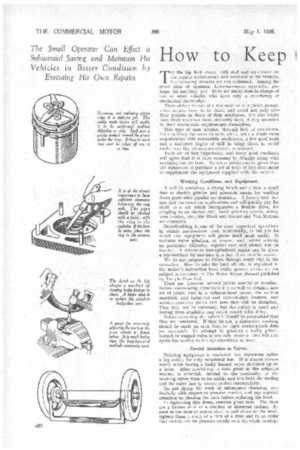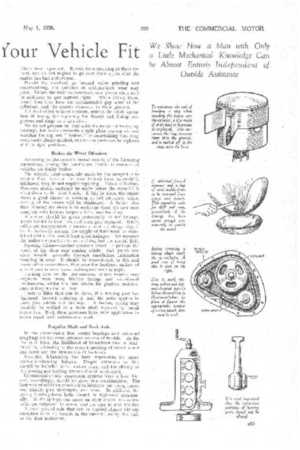How to Keep (our Vehicle Fit
Page 120

Page 121

If you've noticed an error in this article please click here to report it so we can fix it.
TO the big fleet owner, with staff and equipment for the regular maintenance and overhaul of his vehicles; the following remarks are not addressed. Among the small class of operator, however—more especially, perhaps, the ancillary user—there are many men in charge of one or more vehicles who have only a smattering of mechanical knowledge.
These obtain the aid of a mechanic or of a public garage, when repairs have to he done, and could not only save their pockets or those of their employees, but also might have their machines more efficiently kept, if they attended to their mechanical requirements themselves.
This type of than refrains, through lack of confidence, from tackling the work himself, when, with a shade more acquaintance with automobile mechanism, a few good tools and a moderate degree of skill in Using them, he could easily reap the advantages already mentioned.
Tools are of first importance, and every good mechanic will agree that it is false economy to struggle along with any-thing but the best. No better advice can be given than the injunction to purchase a set of tools of first-class make to supplement the equipment supplied with the vehicle.
Working Conditions and Equipment.
A well-lit workshop, a strong bench and a vice, a small foot or electric grinder and adenuate means for washing down parts with paraffin are desirable. A luxury tool, but one that has countless applications and will quickly pay for itself, is a set which 'incorporates a flexible drive, for coupling to an electric drill, small grinding wheels, rotary wire brushes, etc.; the Black and Decker and Van NorMan are examples.
Decarbonizing is one of the most important operations in vehicle maintenance, and, incidentally, is the job for which this equipment will prove itself most useful. It includes valve grinding, of course, and, whilst offering no particular difficulty, rnquires care and should not be hurried. A side-valve four-cylindered engine can be given a top-overhaul by one man in a day, if no time be wasted.
We do not propose to follow through every step in the operation. How to take the head off, etc. is explained in the maker's instruction book whilst general advice on the subject is contained in The Motor Repair Manual published by Temple Press Ltd.
There are, however, several points worthy of mention. Before commencing operations it is as well to obtain a new set of joints, that is, a cylinder-head gasket, the various manifold, and induction and exhaust-pipe washers, and water-connection joints and hose that will be disturbed. They may not be necessary, but the outlay is small and having them available may avoid considerable delay.
Before extracting the valves it should be ascertained that they are numbered. If they be not, a distinctive marking should be made on each (one to eight centre-punch dots for example). To attempt to grind-in a badly pitted, burned or warped valve is not only waste of time but also spoils the seating in the Cylinder-block or head.
Careful Attention to Valves.
Refacing equipment is marketed, but represents rather a big outlay for only occasional use. It is almost always worth while having a badly burned valve skimmed up on a lathe. After machining, a final grind in the orthodox manner is essential. Attend to the continuity, of the marking rather than to its width, and test both the seating and the valve face to ensure perfect concentricity.
Do not skimp the work of subsequent cleansing, particularly with respect to abrasive matter, and pay especial attention to cleaning the faces before replacing the head.
In tightening this down, exercise great care. The risks are a broken stud or a cracked or distorted casting. So soon as the nuts or screws start to pull down on the head, tighten them a sixth of a turn at a time and in an order that -distributes the pressure evenly over the whole casting;
this is most important. Refrain from straining at them too hard, but do not neglect to go over them -again after the engine haS had a short run.
Should the overhaul go beyond valve grinding and decarbonizing, the question of cylinder-bore wear may arise. Unless the wear be excessive, new piston rings may be sufficient to put matters right. When fitting them, insure that they have the recommended gap when in the cylinders, and the correct clearance in their grooves.
If it be decided to have a rebore, entrust the whole operation of boring (or replacing the liners) and fitting new pistons and rings to a specialist.
We do not propose to deal with the matter of taking up bearings, but never dismantle a split plain bearing without marking the cap and " brasses," or ascertaining that thy are already clearly marked, so that the parts can be replaced in their right positions.
Brakes the Worst Offenders.
• According to the recently issued reports of the Licensing Authorities, among the commonest defects in commercial vehicles are faulty brakes.
The mistake most commonly Made by the inexpert is to assume that, because the shoe facings have 'appreciable thickness; they do not require replacing. This is fallacious. Renewals should certainly be made before the material is worn down to the rivet. heads. If this be done, the brakes stand a good chance of working at full efficiency, whilst • scoring of the drums will be minimized. A better plan than refacing the shoes is to exchange them for new ones complete with facings properly fitted and .trued up.
Attention should be 'given periodically to the linkage. joints should be kept free, and worn pins replaced. Where cables are incorporated, a broken strand is a danger signal. In the hydraulic system, the supply of fluid must be maintained and a close watch kept upon leakages. We reiterate the maker's injunction to use nothing but the special fluid.
Steering failure—another common defect—is perhaps the result of the drop arm coming • adrift. Ball joints also cause trouble--generally through insufficient lubrication resulting in wear. It should be remembered, in this and many other connections, that once the hardened surface of a steel part is worn away, subsequent wear is rapid.
Turning now to the transmission, clutch trouble may originate from worn friction facings and withdrawal mechanisms, whilst the best advice for gearbox maintenance is keep up the oil level.
There is little that can be done, if a moving part has liactured, beyond replacing it, and the same applies to worn gear wheels and bearings. A broken casing may possibly be welded or a worn shaft repaired by metal deposition. Both these processes have wide application in motor repair and maintenance work.
Propeller Shaft and Back Axle.
In the transmission line, centre bearings and universal couplings are the most probable sources of trouble. As for the final drive, the likelihood of breakdown can be minimized by attending to the correct meshing of crown wheel and bevel and the elimination of backlash.
Imperfect lubrication has been responsible for many mad-wheel-bearing failures. Proper attention to this should be included under maintenance, and the efficacy of the bearing-nut locking-devices should be checked.
. Commercial-vehicle suspension systems have a hard life, and, accordingly, should be given due consideration. The best way of avoiding trouble is to lubricate the spring leaves and shackle pins thoroughly and often. In addition, the spring holding-down bolts should be tightened occasionally. If the springs can move on their chairs, the centre bolts are subjected to stress, and are sure to give trouble.. A good general rule that can he applied almost without exception is to nip trouble in the bud—to rectify the fault at the first indication.








































































































































































